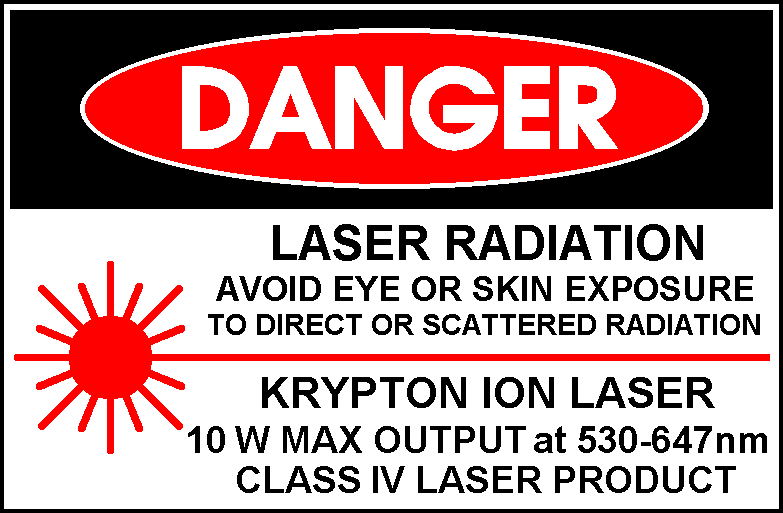
You Only Received One Set of Eyeballs?
Lasers have tended to be high glamor devices popular with with hobbyists, experimenters, entertainers, and serious researchers alike. However, except for very low power lasers - those with less than a fraction of a mW of beam power - they do pose some unique hazards particularly with respect to instant and permanent damage to vision. The visual receptors (the light sensitive cells) lining the eye's retina are part of the central nervous system and do not regenerate. You're pretty much born with your lifetime allocation.
Here we only discuss the hazards with respect to vision. There are other safety issues - such as the danger from the high voltages used to power certain types of laser. These are summarized later in this chapter and dealt with in more detail in the chapters on the lasers for which they apply. There are several reasons that even small lasers which do not represent any sort of burning or fire risk can instantly and permanently damage vision:
The output of many lasers is a nearly parallel - highly collimated - beam which means that not only is the energy concentrated in a small area but the lens of the eye will focus it to a microscopic point on the retina instantly vaporizing tissue in much less than the blink of an eye. A collimated beam represents the rays from an object at infinity so if your eye is focused for distance, the laser will be in focus as well. Even a common helium-neon laser without external optics will approximate a point source a .5 meter or more behind the exit window of the laser. Where your are working in a small room, this approximate distance would likely be where your eyes are focused. While purists might argue that the lens of the eye isn't perfect and will not produce a diffraction limited spot on the retina, this won't save your vision! The power density in a sub-optimal spot can still be astronomical.
A cheap laser pointer also produces a highly collimated beam.
Even at power levels considered relatively safe, one shouldn't deliberately stare into the beam for any reason. For these relatively low power lasers, permanent eye damage is not that likely but why take chances? For these lasers, viewing the spot projected on a white surface is perfectly safe.
A 100 W light bulb puts out about 5 to 7 W of visible light and another 35 to 40 W in the near-IR which is also relevant since it passes through glass, water, and the anterior structures of the eye can be focused on the retina. The rest is mid to far-IR and heat with a small amount of UV tossed in. All of this radiation is more or less uniformly distributed in every direction. However, at any reasonable distance from the light bulb, the power density (e.g., W/mm2) entering the eye is much lower than for a collimated laser beam of even very low power. And, it takes significant effort to produce any sort of truly collimated beam from such a non-point source such as is present with even the filament of a clear light bulb. For a frosted light bulb, insert another factor of a thousand or so. :) Without collimation, even the portion of that additional 35 to 40 W of near-IR that enters the eye isn't going to cause damage. However, for a helium-neon laser, the collimation is such that the entire beam (total power output of the laser) will still be small enough to enter the eye even at a distance of several meters.
For example, at 10 cm from a 100 W bulb (which would be a very uncomfortable place to be just due to the heat), the power density of the visible light (assuming 5 total watts) would be only about 0.05 mW/mm2. At 1 m, it would be only 0.0005 mW/mm2 or 500 mW/m2. Based on this back-of-the-envelope calculation, a 5 mW laser beam spread out to a circular spot of 0.1 m diameter (i.e., 1 mR divergence at a distance of 100 m - without external optics) will appear brighter than the 100 W light bulb at 1 m! And, close to the laser itself, that beam may be only 1 *mm* in diameter and thus 10,000 times more intense! (And note that the other invisible radiation that passes through to the back of the eye is still not nearly as dangerous as the beam from the 1 mW laser because it isn't focused to a tiny spot by the lens.)
As another point of reference, the mid-day Sun at the Earth's equator on a clear day has a power density of about 1 kW/m2 or about 1 mW/mm2. It would not take very long staring into the Sun to burn out your eyeballs! (Yes, I know, some people have claimed to do this all day without harm - I wonder what a vision test would reveal?)